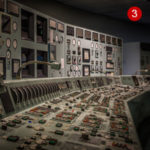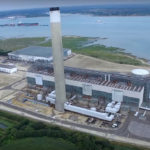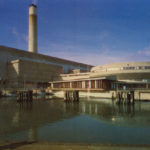
Generating electricity since 1972, Fawley was an oil fired power station on the western shore of Southampton Water in Hampshire.
Commissioned by the CEGB, Fawley was built by Mitchell Construction, comprising 4 sets of 500MW Parsons generating units, totalling 2GW capacity. Two units were mothballed in 1995, leaving 1GW capacity remaining.
The power station has a few unique and interesting architectural features designed by architect Colin Morse. The boiler house is clad in marine grade glass arranged in a zig-zag pattern, which still looks modern and shiny to this day. By the late 1960s, not only the huge main buildings of power stations were designed to make a statement, attention to the ancillary buildings was also being drawn. No other power station reflects this more than the “flying saucer” design of the control building, a large round structure juxtaposed against the straight lines of the expansive turbine hall and towering boiler house behind. Flanking the control building with another huge contrast of design elements, the canteen building is formed from triangular concrete sections.
To minimise the visual impact the power station would have on the surroundings, Fawley was built in a 24 foot deep trench. Unusually, the turbine floor is at ground level, and the lower level of the turbine hall is within a basement. The result is the building, with the exception of the 650ft chimney, is hardly visible from the surrounding areas. The only place to view the building in its entirety is from the Solent or immediate shoreline.
Fawley was never used to full capacity. Being built just before the oil crisis of the 1970s meant it was expensive to run, despite being listed as the most efficient power station in the UK at the time. The power station opted out of the Large Combustion Plant Directive (LCPD), meaning it would not comply with new emissions regulations and therefore could operate for no more than 10,000 hours until the end of 2015. Owners RWE announced closure in 2012 and the station generated electricity for the last time on 31 March 2013.
Buildings and Plant Detail

The boiler house is clad in marine grade glass and contains oil-fired boilers.
A huge control room sits atop a unique round structure with various facilities below.
Fawley Image Gallery
Visit the plant detail pages above to view more images from each area of the power plant
Image references:
- Unknown
- Gene (GFDL CC Licence)
- MHG Heating





 Turbine Hall
Turbine Hall Boiler House
Boiler House Control Room & Admin
Control Room & Admin







12 thoughts on “Fawley Power Station, Southampton”
From March 1965 onwards I was the Control and Instrumentation Maintenance Engineer at Fawley. In March 1983 I became the Resource Planning Manager following a staff reorganisation. I retired in 1991 soon after privatisation of the CEGB.
Fawley was the first computer controlled power station in Europe. Part of my remit was the maintenance of the 4 English Electric KDF7 mainframe computers. As part of the design many instrument systems were duplicated, one for conventional display and recording in the central control room with the other input to KDF7. Consequently there were over 23,000 pieces of instrumentation equipment installed, far more than in a coal fired station.
Each of the 4 boilers had 32 oil burners which were controlled via complex local systems.
Unfortunately due to problems with the oil burner controls and the feed heating plant in particular the computers were never able to fully control the units. However their partial control was used successfully.
I remember it well Tony. I was s shift instrument mechanic from Sept 1969 after completing my apprenticeship at East Yelland and Berkeley. I became the youngest Shift Foreman in CEGB in 1972. I left Fawley to join the cane sugar industry in 1976 and have been running my own consultancy and specialist instrumentation business since 1986. The CEGB was a tremendous starting ground providing first rate training that rarely exists today.
I came all the way down from the Highlands of Scotland as I was told by a neighbor of mine in the Highlands that there was plenty of work in June / July 1965 “like a 21-year-old” straight out of college in Inverness having worked in the Construction Industry for 4 years previously with my C&G under my arm in Concrete Technology. After arriving at the security gates something new to me with no job or even an interview, I simply told the Security Guard that I needed to speak to personal, I told them that I had relevant Qualifications to work here. I was subsequently guided to the door of Mr. M B Cooke and was taken on straight away as a Concrete Technician. I was given accommodation in F block which was salaried staff only and for the next 3 1/2 years I was to spend many days and some nights testing all manner of concrete materials including working closely with Graham Hall on a paper published in the New Civil Engineer June 1971 on the design of concrete to be pumped over long distances on which some of the practices were still in place in recent times, for me it would be a great privilege for me to come down and see it for one last time, as there is so much else I could say. I Was to spend many more happy and fruitful years of my life testing all manner of construction materials on other major projects throughout the UK.
I worked there on a contract from late 73 to mid 74 working in conjunction with Southern Projects Group. My job was to test the various inputs to the Unit 4 KDF-7 Mainframe. This would involve dialing up the address on a particular piece of machinery on the Computer and seeing what reading I was getting. If there was no reading I then had to trace the signal from the computer out to where ever it was to see why there was a problem. It was a fantastic job and it catapulted me into the IT Industry which I am still in 45 years later
I worked on the construction of the site ,my self and two others glazed all the turbine hall and the front elevation.Faulkner Green was the glazing co London
Dear Tony, Edward, Francis, Paul and Kevin
I’m a professional playwright working in the New Forest with Forest Forge Theatre Company, Waterside Heritage Centre and New Forest Heritage Centre. I’m being funded by Arts Council England to write a new play based on people’s relationship to Fawley Power Station. Your stories sound fascinating and I’d love to hear more.
As I’m sure you know, the power station is due for full demolition and a new housing development – Fawley Waterside – will be built and completed in its place by 2026. The play has been commissioned by Forest Forge who make work about, with and for the communities of the New Forest. The Waterside area and in particular the industrial nature of it has often been overlooked, and we really want to listen to, understand and collect the many and varied experiences people have of the Power Station – from its build in the 1960s until today and its forthcoming demolition – whether they worked there, or felt it had a big influence on their life in the community. Everyone’s stories and experiences are of interest, no matter how small they might seem.
If you’d be interested in talking to me or hearing more about the project, it would be great to hear from you. If you know others that might also be interested, please do spread the word that we’re on the lookout for people’s stories and to explore and celebrate the amazing influence this incredible building had on the local community, before it’s gone forever.
Thanks so much for reading this. I hope to hear from you. And to the website organiser – this is a fantastic resource! Thank you. It’s been a really great introduction to Fawley.
My father worked here as a shift engineer Keith Hammond from the building stage and many years afterwards. I often used to go into work with him and learn in the workshops as a child .also remember never a shortage of batteries or hamerite paint from the stores. Originally we lived at 14.langdown lawn close in Hythe where the garage which is still standing was built by contractors as a favour to my father with the spare lining flue bricks from the chimney and a pit and floor all laid as a “favour ” .we moves from there just down the road to malthouse cottage. Sadly my father died a few years ago but I managed to keep some of the original tools and paperwork from the station including all his original documents about the gas turbines and course with RR he had to do
You mention some ‘unique and interesting architectural features’ – it would be great if you could also mention the Architect: Colin Morse F.R.I.B.A. He also designed La Collette Power Station in Jersey (Building constructed 1963-1965).
2 years on the construction of the 4 boilers as boiler maker plater,with dad and brother as pipe fitters on different firm.clarke chapman and john tompson being main contractors after mitchell had finished all the ground work buildings.it was a credit to hundreds of tradesman from all over the country.like clearing your shed out next week you need it
Ivor maddock 1969 to 1979 b shift mmd
I worked at Fawley P Stn for a short time 1985/86 in Mangement Services with the great Don Smith as my mentor. Don was into the Burroughs micro computers [B20 series] and his Apple.
I helped look after the B1955, with Graham, and built the B25 network around ” Space City” . Great days.
I have a feeling that the Don smith you speak about was my grandad as I know he worked at the power station with computers